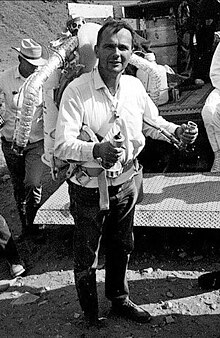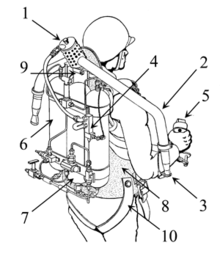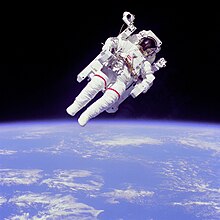Rocket backpack

A rocket backpack . even jet pack or Jetpack is on the rebound principle (usually hot combustion gases ) -based portable power unit with which a single person can move freely in the air (or in space). The term jet pack is a derivation of the English word for backpack, alluding to how the device is carried.
Known copies
JetPack International
Since JetPack International was founded in 2003, more than two thousand successful flights have been completed. There are currently three different models on offer with a flight time of 33 to 43 seconds (two hydrogen peroxide versions for demonstration purposes) and up to nine minutes (one version with turbines).
Bell Textron Jet Pack
In the early 1960s , the American Bell Textron developed a jet pack for the US Army, known as the Rocket Belt . This jet pack had a jet drive that worked with superheated steam . One pressure cylinder contained nitrogen gas, with which highly concentrated hydrogen peroxide was pressed from two other cylinders onto a catalyst ; There, the hydrogen peroxide decomposed to a mixture of water vapor and oxygen with a temperature of approx. 740 ° C under intense heat generation . This superheated steam was fed through two insulated, curved lines to the nozzles, where it provided the recoil . The pilot had to wear insulating clothing to protect against scalding from the hot water vapor escaping.
Such a rocket belt was already used in the 1965 James Bond film Fireball . This jet pack was also demonstrated in the opening ceremony of the Olympic Games in Los Angeles (1984) . It could carry a single person over nine meters tall obstacles and reached a speed of 11 to 16 km / h . However, its flight time was limited to 20 seconds. A later further development from the years 1995-2000 could improve the flight time to no more than 30 seconds.
In addition to the extremely limited service life, this jet pack was also denied any practical relevance due to the fact that its pilot had no way of landing in a controlled manner in the event of a drive failure ( parachutes are at the low heights that such a jet pack can be achieved, useless). This represents a considerable safety risk and distinguishes the jet pack from airplanes and helicopters , which can land safely even without their own propulsion by gliding or autorotation .
Williams Research
In 1970, Williams International was licensed by Bell Textron to manufacture and sell the Rocket Belt. Williams later developed an improved version that, unlike other models, did not use a rocket, but a turbine as a drive. This allowed the flight time to be increased to around 30 seconds. The development was not pursued further, however, because the device was less cost-effective than a helicopter and needed an experienced, specially trained pilot.
Jetpack Aviation
Jetpack Aviation (CEO and test pilot: David Mayman, chief designer: Nelson Tyler) have developed a jet-powered, back-mounted aircraft that, according to the company, can reach a maximum altitude of around 3,000 m, a maximum speed of over 100 km / h (68 mph ) in forward flight and flight times of up to 10 minutes. The inaugural flight of the Jetpack JB9 took place in November 2015 off New York with an FAA-approved sightseeing flight around the Statue of Liberty.
Space rocket backpacks
Manned Maneuvering Unit (MMU)
Its area of application is space, where it can operate from the space shuttle and enables an astronaut to move independently of it to a limited extent.
The control torques on the MMU are generated by nitrogen gas that is under high pressure and exits through nozzles (the MMU has twenty-four nozzles in total).
Only an environment like space, in which the astronauts are subject to weightlessness , enables this technology to be used effectively, since in this environment there is no need to constantly apply thrust in order to ensure buoyancy. In space, all of the fuel is available for the actual control of the device, while under the influence of gravity by far the largest part of the energy has to be used for lift.
The MMU has been used in three shuttle missions since 1984 ( STS-41-B , STS-41-C and STS-51-A ).
Simplified Aid for EVA Rescue (SAFER)

SAFER is a simplified form of the MMU device. It is used as a rescue system during spacecraft missions on the space shuttle or the international space station in the event that the spaceman’s safety line should fail.
The SPK was the Soviet counterpart to the MMU. It was tested in free flight at the Mir space station .
In popular culture
- Probably the most famous appearance is made by a rocket backpack in the opening scene of James Bond 007 - Fireball . The same rocket backpack was also used for the opening ceremony of the 1984 Summer Olympics .
- In the Star Wars films, Jango Fett and later his son Boba Fett use a rocket backpack .
- In the movie Running Man , the killer Fireball uses a rocket backpack.
- In the finale of the animated film Batman and the Phantom , the Joker tries to avoid a huge explosion with a rocket backpack.
- In the comic book series The Rocketeer , the eponymous character wears a rocket suite.
- Tony Stark's Iron Man suite has integrated the functions of a rocket backpack.
- There are jet packs in numerous computer games, including Worms World Party , GTA: San Andreas , Command & Conquer: Red Alert 2 , Halo , Fallout 4 .
- In the final scene of the 2014 film The Penguins from Madagascar , right before the credits, the four penguins fly with jetpacks in a spiral around the Statue of Liberty and finally vertically into the sky.
See also
- Flyboard Air , a one-person aircraft
Web links
Individual evidence
- ↑ Jetpack Aviation ( memento of April 18, 2017 in the Internet Archive ), accessed on April 17, 2017
- ↑ Irrelevant, sir. Jetpacks are awesome! Retrieved December 12, 2018 .


